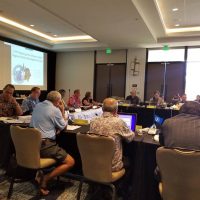
Federal fishery managers, meeting this week on Maui, Hawaii, have recommended an increase in the annual catch limit (ACL) for seven species of main Hawaiian Islands deep-water bottomfish species.
The ACL increase from 306,000 pounds to 492,000 pounds would apply to fishing years 2018-19, 2019-20 and 2020-21.
The new limit recommended by the Western Pacific Regional Fishery Management Council is based on an assessment of the fish stock completed by the National Marine Fisheries Service (NMFS) in 2018.
The recommendation will be sent to the Secretary of Commerce for final approval.
Known as the Deep 7, the species include sea bass and six snappers:pink snapper, longtail snapper, squirrelfish snapper, silver jaw jobfish, brigham’s snapper and von siebold’s snapper.
The season for the fishery runs from September 1 to August 31 of the following year, unless the catch limit is reached before August 31. If the Annual Catch Limit is reached, the fishery would close for the remainder of the fishing year.
Council members from American Samoa include Director of Marine and Wildlife Reoursces Vaamua Henry Sesepasara, Archie Taotasi Soliai and Christina Lutu Sanchez.
In other decisions reached at this week’s Council meeting:
The Council voted to move some species from the “management unit species” category to “ecosystem component” category in the fishery ecosystem plans (FEPs) for the Hawaii, American Samoa and Mariana Archipelagos.
The Council will work with American Samoa, Guam and the CNMI to improve the accuracy and timeliness of catch reports. It will assist the Territorial fishery agencies to develop regulatory solutions such as mandatory licensing/permit and reporting (e.g., logbooks).
The Council will also help the US Pacific Territories and the State of Hawaii to develop and improve data collection systems, such as a) dedicated port sampler to conduct a full census of the bottomfish catch; b) more timely data transcription; and c) potential improvement and expansion of the commercial receipt book program, including an online cloud database.
In addition the Council will work with National Marine Fisheries Service to investigate potential mechanisms to improve the local fishing agencies ability to address data collection logistical issues.
The Council also asked the Western Pacific Fishery Information Network to explore other means of expanding data collected through creel surveys.
With regards to derelict vessels, the Council asked the US Coast Guard to develop a process to notify local governments, neighboring countries and mariners of derelict vessels and potential hazards to navigation and threats for vessel grounding.
The Council additionally asked the Coast Guard to investigate satellite tracking technologies that could be deployed on derelict vessels.




